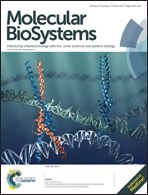Soluble epoxide hydrolase inhibitors might prevent ischemic arrhythmias via microRNA-1 repression in primary neonatal mouse ventricular myocytes†
Abstract
Ischemic arrhythmias are the main causes of sudden cardiac death. It has been reported that soluble epoxide hydrolase inhibitors (sEHis) could prevent arrhythmias; however, the underlying molecular mechanisms remain unclear. In recent years, the proarrhythmic role of microRNA-1 (miR-1) has been investigated. This study aimed to elucidate whether sEHis prevented ischemic arrhythmias by suppressing miR-1. The primary neonatal mouse ventricular myocyte model of miR-1 overexpression was established by incubating with agonist microONTM mmu-miR-1a-3p agomir (DAEDstainTM Dye) (agomiR-1). The sEHi, trans-4-[4-(3-adamantan-1-yl-ureido)-cyclohexyloxy]-benzoic acid (t-AUCB), was administered following miR-1 overexpression. Quantitative real-time PCR (qPCR) and western blotting were used to test alterations in the expression of miR-1 and its target mRNAs GJA1 and KCNJ2 and their respective encoded proteins connexin 43 (Cx43) and the K+ channel subunit (Kir2.1). The whole-cell patch-clamp technique was used to record the alterations of the inward rectifying K+ current (IK1). Compared with the control group, miR-1 levels were significantly increased in the agomiR-1 group (p < 0.05), which suggested the successful construction of the miR-1 overexpression model. Compared with the control group, the levels of GJA1 and KCNJ2 mRNAs and Cx43 and Kir2.1 proteins in the agomiR-1 group were significantly decreased, and IK1 was significantly impaired (all p < 0.05). The miR-1 levels were dose-dependently decreased by t-AUCB, whereas t-AUCB dose-dependently increased the levels of GJA1 and KCNJ2 mRNAs and Cx43 and Kir2.1 proteins. Furthermore, t-AUCB restored the impaired IK1 (all p < 0.05). In conclusion, the sEHi t-AUCB has the ability to down-regulate proarrhythmic miR-1 and up-regulate its target genes and proteins, eventually restoring IK1.


 Please wait while we load your content...
Please wait while we load your content...